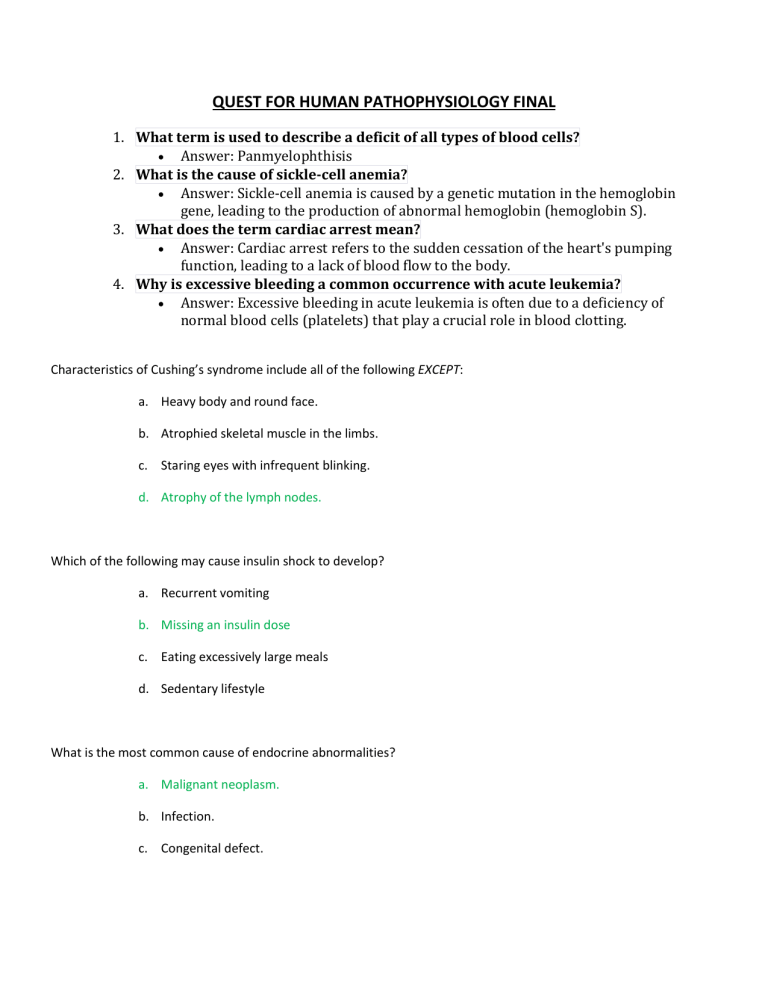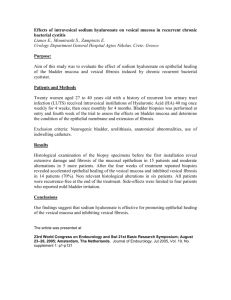
QUEST FOR HUMAN PATHOPHYSIOLOGY FINAL 1. What term is used to describe a deficit of all types of blood cells? Answer: Panmyelophthisis 2. What is the cause of sickle-cell anemia? Answer: Sickle-cell anemia is caused by a genetic mutation in the hemoglobin gene, leading to the production of abnormal hemoglobin (hemoglobin S). 3. What does the term cardiac arrest mean? Answer: Cardiac arrest refers to the sudden cessation of the heart's pumping function, leading to a lack of blood flow to the body. 4. Why is excessive bleeding a common occurrence with acute leukemia? Answer: Excessive bleeding in acute leukemia is often due to a deficiency of normal blood cells (platelets) that play a crucial role in blood clotting. Characteristics of Cushing’s syndrome include all of the following EXCEPT: a. Heavy body and round face. b. Atrophied skeletal muscle in the limbs. c. Staring eyes with infrequent blinking. d. Atrophy of the lymph nodes. Which of the following may cause insulin shock to develop? a. Recurrent vomiting b. Missing an insulin dose c. Eating excessively large meals d. Sedentary lifestyle What is the most common cause of endocrine abnormalities? a. Malignant neoplasm. b. Infection. c. Congenital defect. d. Benign tumor. What is the basic pathologic change with macular degeneration? a. Increased amount of aqueous humor in the eye. b. Movement of vitreous humor between the retina and the choroid. c. Degeneration of the retinal cells in the fovea centralis. d. Damage to the optic nerve and meninges. Which disease is associated with excessive dopamine secretion, decreased gray matter in the temporal lobes, and abnormal hippocampal cells in the brain? a. Creutzfeldt-Jakob disease. b. Schizophrenia. c. Panic disorder. d. Depression. Which of the following are common early signs of multiple sclerosis? a. Paralysis of the lower body, impaired cognitive function. b. Tremors, weakness in the legs, visual problems. c. Sensory deficit in the legs and trunk, memory loss, urinary incontinence. d. Tremors, speech impairment, hearing loss. The micturition reflex is initiated by: a. sympathetic nerves in the sacral spinal cord. b. relaxation of the internal sphincter of the bladder. c. increased pressure distending the bladder. d. contraction of the bladder. Which of the following is a predisposing factor to bladder cancer? a. Prostatic cancer. b. Hormonal abnormalities. c. Exposure to chemicals and cigarette smoke. d. Presence of embryonic tissue. Renal disease frequently causes hypertension because: a. Albuminuria increases vascular volume. b. Congestion and ischemia stimulates release of renin. c. ADH secretion is decreased. d. Damaged tubules absorb large amounts of filtrate. Which of the following is NOT a function of the kidney? a. Regulation of body fluid concentrations. b. Removal of nitrogenous and acidic wastes. c. Activation of vitamin D. d. Production of albumin. What is the cause of inflammatory bowel disease? a. Physical and emotional stress. b. An autoimmune reaction. c. A combination of recessive genes. d. Idiopathic. How may a fistula form with Crohn’s disease? a. Lack of peristalsis leading to dilated areas of intestine. b. fibrosis and thickening of the wall causing obstruction. c. erosion of the mucosa causing bleeding. d. recurrent inflammation, necrosis, and fibrosis forming a connection between intestinal loops. What are the typical changes occurring with Crohn’s disease? a. Degeneration and flattening of the villi in the small intestine. b. Multiple herniations of the mucosa through weak areas of the muscularis. c. A continuous area of mucosal inflammation and ulceration in the rectum and colon. d. Inflamed areas of the wall of the ileum alternating with thick fibrotic or normal areas Obstruction in the upper airway is indicated by: a. Stridor. b. Rales. c. Wheezing. orthopnea During an acute asthma attack, how does respiratory obstruction occur? 1. Relaxation of bronchial smooth muscle. 2. Edema of the mucosa. 3. Increased secretion of thick, tenacious mucus. 4. Contraction of elastic fibers. a. 1, 2 b. 1, 3 c. 2, 3 d. 2, 4 The basic pathophysiology of cystic fibrosis is considered to be: a. an abnormality of the exocrine glands. b. impaired function of the endocrine glands. c. chronic inflammatory condition of the lungs. d. an abnormal immune response in the lungs and other organs. Which of the following is a major factor contributing to the current increase in cases of tuberculosis? a. Increased use of BCG vaccine. b. The increase in immunodeficient individuals. c. The lack of effective medication. d. Increased use of unpasteurized milk. What is the most common cause of viral pneumonia? a. Rhinovirus b. influenza virus c. Haemophilus influenza d. Pneumococcus Which of the following causes bronchodilation? a. Epinephrine. b. Histamine. c. Parasympathetic nervous system. d. Drugs that block beta-2 adrenergic receptors. Why does cyanosis occur in children with tetralogy of Fallot? a. More carbon dioxide is present in the circulating blood. b. A large amount of hemoglobin in the general circulation is unoxygenated. c. The pulmonary circulation is overloaded and congested. d. The circulation is sluggish (slow) throughout the system. Which of the following best describes the basic pathophysiology of myocardial infarction? a. Cardiac output is insufficient to meet the needs of the heart and body. b. Temporary vasospasm occurs in a coronary artery. c. Total obstruction of a coronary artery causes myocardial necrosis. d. Heart rate and force is irregular, reducing blood supply to coronary arteries. Which of the following causes increased heart rate? a. Stimulation of the vagus nerve. b. Increased renin secretion. c. Administration of beta-blocking drugs. d. Stimulation of the sympathetic nervous system.


